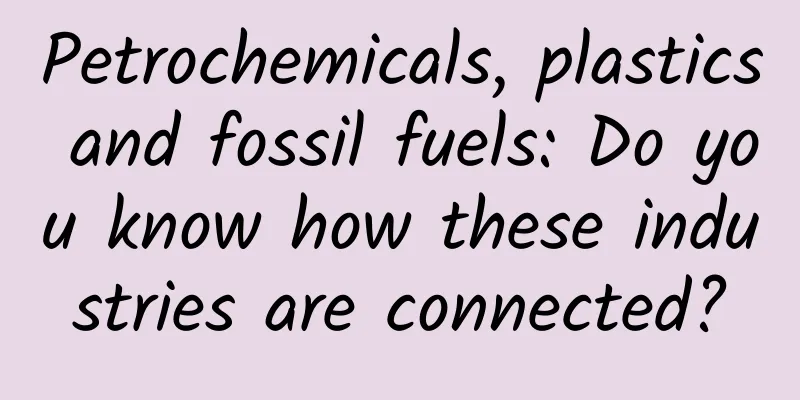Petrochemicals, plastics and fossil fuels: Do you know how these industries are connected?

|
Did you know? More than 99% of plastics are made from chemicals derived from fossil fuels. There is a strong connection between fossil fuels and the plastics industry. Understanding these industry connections and their role in driving plastic production and plastics investment is critical to addressing the growing global plastic pollution crisis and identifying the role that corporate actors play in this crisis. This article is compiled from the report "Petrochemicals, Plastics and Fossil Fuels" by the Center for International Environmental Law (CIEL). It will introduce the role of fossil fuels in plastic production, the process from fossil fuels to plastics, and reveal the deep connection between fossil fuels and the plastics industry and its products. Overview • Chemicals used in plastic production are almost entirely derived from fossil fuels. • Because fossil fuel production processes are highly localized, plastic production is also concentrated in areas with high fossil fuel production (particularly the Gulf Coast of the United States). • Natural gas liquids (NGL), a key raw material for plastic production, are difficult to transport over long distances. Therefore, petrochemical producers that use NGL or ethane as raw materials usually prefer to gather around natural gas production areas. The current shale gas boom in the United States is driving a large-scale expansion of plastic industry infrastructure in the Gulf of Mexico. • Naphtha is another key raw material in plastic production. As a refined product, its production is concentrated in the major oil companies with refining capacity. In fact, just five major companies (BP, Chevron, ExxonMobil, Shell and China National Petroleum Corporation) provide more than half of the world's naphtha sales. • Because fossil fuel extraction and plastics production are brought together, there is a high degree of vertical integration between the two industries; many large oil and gas producers own plastics companies; likewise, many large plastics producers own oil and gas companies. DowDuPont, ExxonMobil, Shell, Chevron, and BP are all integrated companies that operate both. Sources of plastic Although plastic is something we come into contact with every day, many people don't know where plastic comes from or even what the exact term "plastic" is. Broadly speaking, plastic is a material formed from organic polymers. Organic polymers are long chains of macromolecules that are made by polymerizing multiple smaller molecules (called monomers). However, these monomers almost always start in the supply chain at an oil wellhead, oil rig, or coal mine, and are themselves products of the supply chain. More than 99% of plastics are made from chemicals that come from fossil fuels. Although there are many different types of plastics, the following five types account for more than 90% of all plastic production (by weight): • Polyethylene (34.4%), • Polypropylene (24.2%) • Polyvinyl chloride (16.5%) • Polyethylene terephthalate (7.7%) • Polystyrene (7.3%)[1] Ethylene is an important raw material for the production of polyethylene (PE), polyvinyl chloride (PVC), polyethylene terephthalate (PET) and polystyrene (PS). These plastics account for about 65% of global plastic production by weight. Propylene is the platform compound for polypropylene①. Therefore, the source of the vast majority of plastics can be traced back to two industrial chemicals: ethylene and propylene[2]. 【Note】 ① Platform Chemicals: refers to a class of basic organic compounds that are abundant in source, low in price and have many uses, such as propylene, benzene, etc. From them, a series of products with huge market and high added value can be synthesized. Ethylene and propylene play a pivotal role in the production of plastic packaging. Plastic packaging is the fastest growing category of plastic products and one of the biggest contributors to the plastic pollution crisis. In the United States, approximately 34% of plastics are used for packaging[3], while in Europe, the figure is 40%[4]. Furthermore, plastic packaging is almost entirely composed of the five thermoplastics mentioned above, the main ones being polyethylene (PE), polypropylene (PP), and polyethylene terephthalate (PET)[5]. Plastic packaging everywhere in supermarkets | Pixabay Raw material selection The United States’ abundant natural gas supply makes natural gas liquids (NGLs) the feedstock of choice for ethylene production. Nearly 90% of ethylene produced in the United States is produced from ethane-rich NGLs[6]; in addition, nearly all ethane and a third of propane are used to produce ethylene[7]. The large natural gas producers (ExxonMobil being the largest[8]) are known to have a natural gas production capacity roughly equal to the total natural gas production in the United States, so it is possible to roughly calculate the amount of ethylene produced in the United States based on natural gas exploration and development[9]. Similar to the United States, the Middle East uses a large proportion of natural gas liquids in ethylene production.[10] In contrast, ethylene produced in China, Europe, Southeast Asia, and Japan is primarily made from naphtha.[11] Naphtha is a product of crude oil refining. Currently, plastic production accounts for 4% to 8% of global oil consumption.[12] However, if trends in oil consumption and plastic production continue as expected, "by 2050, the entire plastics industry could account for 20% of total oil consumption."[13] Because naphtha is not a crude product but a refined product, the naphtha market is highly concentrated. In 2014, five companies that dominate the industry—BP, Chevron, ExxonMobil, Shell, and PetroChina—accounted for more than 50% of the industry’s total revenue.” [14] Olefins are the chemical building blocks for a wide range of petrochemical products, including plastics. Ethylene and propylene are by far the most important olefins[15]. An important difference between using NGLs and naphtha to produce olefins is transportability. NGLs are difficult to transport internationally, while naphtha (like other components of the crude oil market) is easier to transport. Nearly 30% of naphtha production is traded internationally[16]. With the natural gas boom, the United States is expected to surpass the Middle East as the largest exporter of naphtha by 2020 (lower domestic demand for naphtha in the United States will result in more naphtha to export)[17]. The growth in global petroleum feedstock production will also lead to a naphtha oversupply of about 14 million tons by 2020[18]. Growing exports of naphtha and NGLs from the United States have expanded (rather than replaced) plastics production in other parts of the world. Europe led the world in plastics production in terms of output until the 21st century, when Asia, led by China, became the largest plastics production region. In China, investment in the plastics industry has not slowed down; while in Europe, chemical company INEOS is currently planning to expand two ethylene plants and build a new propylene plant on the continent—the first major investment in European chemicals capacity in recent years.[19] These plants will use NGLs shipped from the United States rather than naphtha refined in refineries.[20] Industry consolidation Because plastic production is part of the fossil fuel supply chain, many fossil fuel companies produce plastic resins and products directly or through subsidiaries. For example, the world’s largest privately held fossil fuel company, ExxonMobil, owns a chemical company, Exxon Chemical Company. As a recent press release stated, “More than 90 percent of ExxonMobil’s chemical capacity is integrated into large-scale refineries or natural gas processing plants.”[21] Shell, Chevron, Phillips, Total, and Sinopec (one of China’s largest state-owned oil companies) all own, operate, or have investments in plastics infrastructure. Petrochemical industry giants | CIEL Conversely, some large plastics companies also have fossil fuel businesses. DowDuPont, the world’s largest chemical company, has a hydrocarbon business that, according to its annual report, makes it “one of the world’s largest producers of ethylene, which is used as an internal feedstock for internal consumption by producer Performance Plastics (based in Ohio)”[22]. This has made DowDuPont an unexpected but sizeable player in the development of new areas of natural gas (for example, in Argentina’s Vaca Muerta region)[23]. The second largest plastics producer, LyondellBassell, also operates a refinery in the US Gulf Coast region. For the company, this integration is not only convenient and brings considerable revenue growth, but also can hedge the risk of fossil fuel price fluctuations. When oil prices fall, the company's upstream business profits fall, but the profit margins of the chemical sector rise, allowing the company to recover some of its profits[24]. In 2015, ExxonMobil's chemical sector provided 10% of the company's revenue, but generated more than 25% of its profits[25]. Ethylene and propylene The same market dynamics that affect ethylene production also affect propylene production. Propylene, as a chemical product, is produced primarily as a byproduct of the ethylene production process. The same cracking units that convert ethane to ethylene also convert propane to propylene. However, two trends are changing the global propylene production landscape: First, the United States is producing less propylene due to feedstock changes. Second, China is producing propylene from its vast fossil fuel reserves. Different cracking processes produce different amounts of propylene. As a result of the natural gas boom, many U.S. ethylene producers switched from cracking naphtha to cracking natural gas liquids, which produces less propylene in the new process.[26] In addition, crackers that produce pure ethane streams (as opposed to mixed natural gas liquids, which contain ethane, propane, butane, isobutylene, and pentanes) produce little or no propylene.[27] As this shift slowly took hold, producers began building and operating facilities that “target” propylene production, intentionally using propane as a feedstock to produce propylene instead of just as a byproduct.[28] While this change may separate the explicit link between ethylene and propylene production, it could make U.S. propylene production more decentralized and traceable. Propylene is no longer produced only as a by-product | Pixabay An even more important factor influencing the development of global propylene production is China’s decision to invest heavily in new propylene production facilities. China is already the world’s leading propylene producer. China’s propylene production is expected to grow faster than any other country in the world, and by 2025 its output could grow to more than half of the global market share[29]. By then, the vast majority of the world’s propylene production, as well as China’s ethylene production, will be controlled by state-owned enterprises[30]. in conclusion While not all fossil fuels are used to make plastics, nearly all plastics are made from fossil fuels. Furthermore, the largest players in the fossil fuel industry and the plastics industry—DowDuPont, ExxonMobil, Shell, Chevron, BP, and Sinopec—are all integrated companies that produce both fossil fuels and plastics. Understanding the connections between these industries and their role in driving plastic production and plastics investment is critical to addressing the growing global plastic pollution crisis and identifying the role that corporate actors play in that crisis. End Notes [1] See PlasticsEurope, The Plastic Industry 3 https:// committee.iso.org/files/live/sites/tc61/files/ The%20Plastic%20Industry%20Berlin%20 Aug%202016%20-%20Copy.pdf (last visited July 11, 2017). [2] See PlasticsEurope, Poly-ethyleneterephthalate (PET): Bottle Grade (2008), available at http://www.plasticseurope.org/Documents/ Document/20100312112214-FINAL_EPD_ PET_BottleGrade_270409-20081215-016EN-v1.pdf; Petroleum Technology History Part 2 – Refining Byproducts, http://www.greatachievements.org/?id=3679 (last visited July 12, 2017). [3] See American Chemistry Council, 2012 Distribution of Plastic Resin Sales and Captive Use (2013), available at https://plastics.americanchemistry.com/resin-reportsubscriptions/Major-Markets-2012-Report.pdf. [4] See PlasticsEurope, Plastics – The Facts 2016 (2016), available at http:// www.plasticseurope.org/documents/ document/20161014113313-plastics_the_ facts_2016_final_version.pdf [5] See id.; American Chemistry Council, supra note 3. [6] See How Much Oil Is Used to Make Plastic?, Energy information Administration (last updated May 17, 2017), https://www.eia.gov/ tools/faqs/faq.php?id=34&t=6; Mitsubishi Chemical Techno-Research, Global Supply and Demand of Petrochemical Products relied on LPG as Feedstock (Mar. 7, 2017), available at http://www.lpgc.or.jp/corporate/information/ program5_Japan2.pdf [hereinafter Mitsubishi Presentation]; Jan H. Schut, How Shale Gas Is Changing Propylene, Plastics Engineering (Feb. 20, 2013), https://plasticsengineeringblog. com/2013/02/20/how-shale-gas-is-changingpropylene/. [5] See id.; American Chemistry Council, supra note 3. [6] See How Much Oil Is Used to Make Plastic?, Energy information Administration (last updated May 17, 2017), https://www.eia.gov/ tools/faqs/faq.php?id=34&t=6; Mitsubishi Chemical Techno-Research, Global Supply and Demand of Petrochemical Products relied on LPG as Feedstock (Mar. 7, 2017), available at http://www.lpgc.or.jp/corporate/information/ program5_Japan2.pdf [hereinafter Mitsubishi Presentation]; Jan H. Schut, How Shale Gas Is Changing Propylene, Plastics Engineering (Feb. 20, 2013), https://plasticsengineeringblog. com/2013/02/20/how-shale-gas-is-changingpropylene/. [7] See Charles K. Ebinger & Govinda Avasarala, Natural Gas Liquids 7 (2013), available at https://www.brookings.edu/wpcontent/uploads/2016/06/Natural-Gas-Liquids. pdf [8] See Top 40 producers, Natural Gas Supply Association, http://www.ngsa.org/download/ analysis_studies/Top%2040%202015%20 2nd%20quarter.pdf. [9] It is important to stress, however, that this apportionment is not exact: the ratio of NGL per cubic meter of natural gas in the United States varies between approximately 10% in “dry natural gas” to 30% in “wet natural gas.” See Kinder Morgan, The Role of Natural Gas Liquids (NGLs) in the American Petrochemical Boom 2 (2017), available at https://www.kindermorgan.com/content/docs/ White_Natural_Gas_Liquids.pdf. [10] See Mitsubishi presentation, supra note 6, at 9. [11] Id. [12] See The New Plastics Economy: Rethinking the Future of Plastics, World Economic Forum 7 (2016), available at http://www3. weforum.org/docs/WEF_The_New_Plastics_ Economy.pdf. [13] Id. [14] See Naphtha Market Analysis By Application (Chemical, Energy & Fuel) And Segment Forecasts To 2022, Grand View Research (Mar. 2015), available at http:// www.grandviewresearch.com/industry-analysis/ naphtha-market [hereinafter Naphtha Market Analysis]. [15] See Products & Technology: Olefins, American Chemistry Council, https://www. americanchemistry.com/ProductsTechnology/ Olefins/ (last visited Sept. 11, 2017). [16] See News Release, HIS Markit, By 2020, US to Emerge as Largest Exporter of Light naphtha, Essential for Production of Gasoline and Chemicals, HIS Says (Apr. 21, 2015), available at http://news.ihsmarkit.com/press-release/ chemicals/2020-us-emerge-largest-exporterlight-naphtha-essential-production-gasoline-. [17] See id. [18] See id. [19]See Press Release, INEOS, INEOS Plans Massive European Expansion Programme (Jun. 12, 2017), https://www.ineos.com/news/ineosgroup/ineos-plans-massive-european-expansionprogramme/. [20] See id. [21] See News Release, ExxonMobil, ExxonMobil to Acquire One of World's Largest Aromatics Plants (May 10, 2017), available at http://news.exxonmobil.com/press-release/exxonmobilacquire-one-worlds-largest-aromatics-plants. [22] See Dow Chemical Company, Annual Report on Form 10-K, at 13, filed on EDGAR on Feb. 9, 2017, available at https://www.sec.gov/Archives/edgar/data/29915/000002991516000066/ dow201510k.htm. [23] See Reuters Staff, Argentina Sees Vaca Muerta Investment Reaching up to $8 Billion This Year, Reuters (Apr. 26, 2017, 3:55 PM), http:// www.reuters.com/article/ us-argentina-energyvaca-muerta/argentina-sees-vaca-muertainvestment-reaching-up-to-8-billion-this-yearidUSKBN17S2Q5. [24] See Adam Levine-Weinberg, Big Problems Ahead for Big Oil in 2016, The Motley Fool (Dec. 20, 2015, 2:30 PM), https://www.fool.com/investing/general/2015/12/20/big-problemsahead-for-big-oil-in-2016.aspx. [25] See Jtender Miglani, How ExxonMobil Makes Money? Understanding ExxonMobil Business Model, Revenuesandprofits.com (Mar. 31, 2016), http://revenuesandprofits.com/howexxonmobil-makes-money/. [26] See Jeffrey S. Plotkin, The Propylene Gap: How Can It Be Filled?, American Chemical Society (Sept. 14, 2015), https://www.acs.org/content/acs/en/pressroom/cutting-edge-chemistry/thepropylene-gap-how-can-it-be-filled.html. [27] See id. [28] See Schut, supra note 6. [29] See Mitsubishi Presentation, supra note 6, at 11. [30] See China Focus: China's Ethylene Production Embracing New Era of Expansion, Xinhua Finance Agency (Jan. 4, 2017, 9:55 AM), http://en.xfafinance.com/html/Industries/ Materials/2015/34311.shtml. This article is compiled from the first report in the "Fueling Plastics" series, "Petrochemicals, Plastics and Fossil Fuels". The series was published by the Center for International Environmental Law (CIEL), which reveals the connection between fossil fuels and the plastics industry and advocates studying the entire life cycle of plastics to solve the plastic crisis from the source and fundamentally. - End - Compiled by: Lu Ka, Shu Yanyu Reviewer: Zhou Jun Proofreading: Shu Yanyu, Sherry |
>>: Traditional Naval Etiquette (IV) - Gun Salute
Recommend
What is the specific situation of Mongolia donating 20,000 masks? Where are these masks shipped from?
On March 2, the Mongolian Red Cross donated 20,00...
The real-life version of "The Fifth Element": Can Uber really fill the skies with flying cars within three years?
Whenever the traffic system is paralyzed and the ...
Why doesn't the iPhone 7 Plus telephoto lens work in low light?
This year's dual-camera upgrade to the iPhone ...
Internet TV is constrained by panels and the low-price strategy is no longer effective
LeTV TV, which has always been a disruptor with i...
Exposed! Are “food scraps” cheap and delicious? The truth is…
Recently, the term "food scraps" has gr...
Do ads harm user experience? 4 tips to tell you how to break it!
Whether it is the BAT giants, super media such as ...
Rumor has it that the iPhone 7 will be equipped with these features: 5-inch screen and dual cameras
January 12, Apple has achieved great success in 2...
How does the catering industry make money from short videos?
I recently saw a video where a small noodle shop ...
The novel of Bone Erosion is on Baidu Cloud, the complete novel of Bone Erosion plus extra chapters is on Baidu Cloud, the full text of Bone Erosion plus extra chapters txt is on Baidu Netdisk!
Xia Weiming died, and Shen Xiujin personally sent...
FAW-Volkswagen's volume and price have collapsed. It's time for Chinese companies to rescue it.
FAW-Volkswagen, once the king, sold 124,000 vehic...
2019 Talent GoGo Breaks into Traffic Dealer "SEO and Application Programming" Free Baidu Netdisk Download
Course content introduction Two modules: "SE...
Google's "robot dog" enters service and is tested by the Marine Corps
Google's Legged Squad Support System (LS3) rob...
Zhihu recommended core logic and traffic guide!
This article studies the Zhihu platform from the ...
Operational review: attracting new users and monetizing in online education!
The author of this article starts from his own wo...









